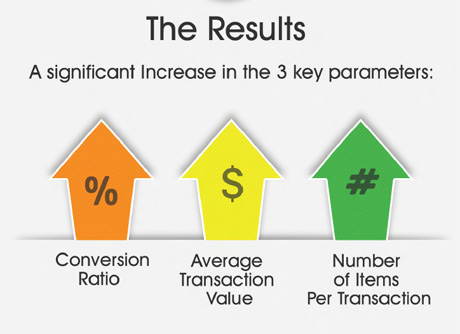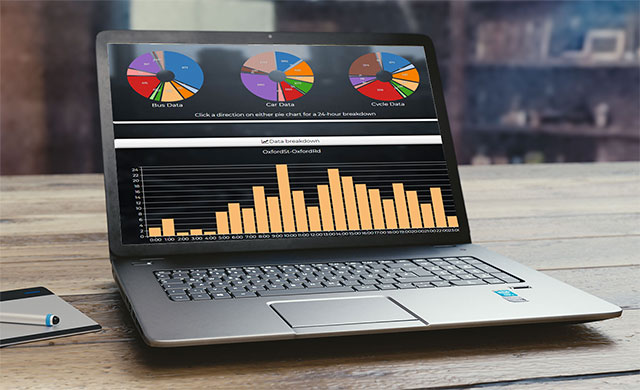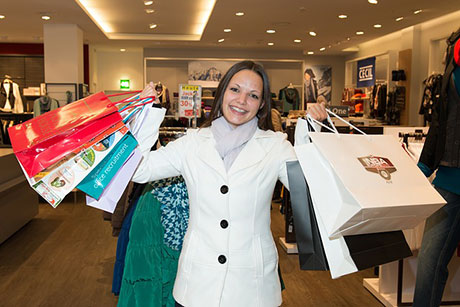Retail traffic counts show easy adjustments that can improve stores' performances across the retail chain.
By acting on the retail analytics an increase of 30% in sales is achievable in just a few months, without any increase in store traffic. Working to improve key performance indicators like average shopping time, dwell time and sales conversion produces a significant impact across the chain.
This is how it's done
- Integrate retail footfall counts with point-of-sale database for real-time sales conversion figures.
- In general, the longer the Average Shopping Time the more people buy. Compare average shopping time across stores to ensure best practice in all.
- Count passers-by: how many people look in the window but don't enter a store? Will changing the window display impact this?
- Monitor queues and test steps taken to reduce them.
- Track the path people take through the stores and see where browsers turn into customers. Use this information to make improvements
- Test effectiveness of displays: see hotspot maps of activity and dwell times. Know exactly how long people pause at displays, stands and kiosks - the longer they remain the more likely they are to buy.
- Efficiently allocate staff - test whether changing staff numbers or working patterns affects key metrics.
- Use these key analytics to optimise performance across the chain.
- Privacy of your customers is maintained - no facial recognition or personal identification is used.

Increasing Sales by Raising Average Shopping Time
The average shopping time reflects the overall level of service in the store. The better the service, the longer people stay and the more likely they are to make a purchase. Measuring and improving average shopping time results in an increase in:
- The number of people buying something
- The number of items they buy
- The amount of money that they spend
This can be accurately measured when the shopping time system is linked with the point-of-sale system. Read how a supermarket chain used average shopping time and other key metrics to sell more items in one of its stores which was underperforming.
Want to find out more?
Please contact us directly for a prompt reply
Longer Dwell Time = More Items Bought
Dwell Time is the length of time a person spends looking at a display or remains a specific area. Studies show that the longer the dwell time, the more likely are people to buy something. Measuring dwell times across the store, and acting to improve them, will increase sales.


Measuring Advertising Success
How do you measure the affects of advertising campaigns? One obvious metric is sales. Has the store sold more products during the campaign? But more sales are only an indirect measurement of advertising success. What if more people entered the store because of the advertising, but less of them bought anything - is that a success or a failure? And what are the reasons for the decrease in sales conversion?
It may be, of course, that the advertising attracted browsers but not prospective customers. It's more likely though that sales conversion was down because of other factors: staffing levels, running out of stock, long queues...Managers can make educated guesses but only by measuring footfall can retailers accurately assess marketing success. Without the footfall traffic figures, no-one knows whether an increase in sales is an indication of a job well done or of opportunities lost. Together with the other retail analytics, managers can pin-point the reasons for success.
Efficiently Allocate Staff
To ensure that the staff are effectively allocated, retail store managers need to know when are their peak shopping times and busiest footfall. A retail traffic counter can show a half-hourly break-down of the counts for the whole day. The counts can be integrated with a workforce management system, making it easy to create better forecasts and staffing schedules.
When shoppers aren't sure what to buy, and don't get helpful advice from retail staff, 90% of them leave empty-handed, according to a recent survey.


Outlook for Retail
The retail industry is becoming more complex and is constantly evolving. In a shifting environment retailers will have to modify their existing strategies to achieve new goals. Retailers need to know the footfall at their shop at regular intervals to remain competitive in the complex retail world.
Experience and Expertise
Retail Sensing have nearly 50 years experience in measurement and control. We have 15000 video counting systems installed in over 40 countries.
Contact
Location:
10 Stocks Street, Manchester, M8 8QG, UK
Email:
Call:

